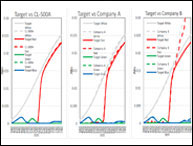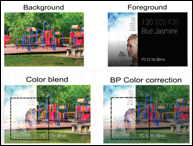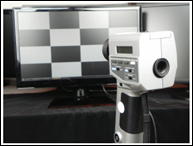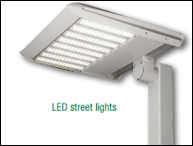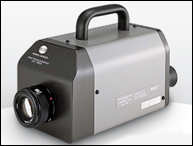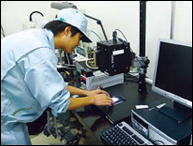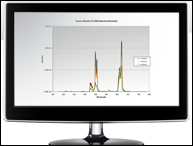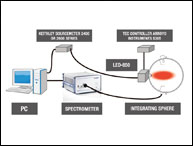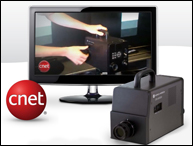CL-500A Spectrophotometer
In recent development of new technologies in light sources, there is increasing demand for an instrument which provides a higher level of accuracy for the measurement data provided. Konica Minolta Sensing's CL-500A is a compact illuminance spectrophotometer which provides distinctive performance to satisfy requirements for high levels of performance in measurement.
CL-500A Illuminance Spectrophotometer
BOLD (Brian Orter Lighting Design) founded by Brian Orter in 2008 is an award winning lighting design firm in New York City. Brian Orter holds 20 years of experience in the lighting design industry establishing himself while attending College at Purchase in New York. BOLD is a small company of 16 employees that takes on lighting projects all around the world. Their team's extensive experience covers, but is not limited to, lighting design for hotels, restaurants, residential, public spaces, corporate headquarters, museums, retail, theater and special environments. BOLD believes that the personality of an environment is born in the concept phase and lighting is integral to the form and the function of a space.
When it came to measuring amber turtle lighting and defining the color and CRI of the overwhelming amount of LED products, BOLD's instrument of choice was Konica Minolta's CL-500A Illuminance Spectrophotometer. They use it mostly in house to test samples, however, on site they use it to measure exterior lighting, art lighting and to verify their calculations. They typically seek color temperature measurements and CRI Values. A major benefit BOLD found from using the CL-500A was quality control. By seeing the individual R values and color spectrums, they were able to avoid a lot of trial and error. Using this meter, BOLD is able to quickly weed out poor light sources from good light sources.
Color Correction For See-Through Displays
Optical See-Through Display (OSTD) is a transparent digital display that simultaneously gives access to the digital content and the real world objects behind it. OSTD is quickly becoming a reality for major industry players such as Epson, Lenovo, Samsung and even Google. These companies have started producing displays for the consumer market.
The major problem with OSTD is color constancy. Color constancy is defined as the ability to perceive the colors of objects, invariant to the color of the light source. In the case of OSTD's, the light from background objects blends with the light originating from the display which causes a color blending problem. Color blending negatively affects the legibility and color coding of digital content which compromises the general usability of these devices. Control over colors is essential for any display, especially with a see-through display which aims to increase one's vision of the world using digital information. There have been many studies performed which confirm the negative effects of color blending with OSTD in content legibility.
LS-100 Luminance Meter Testing Monitors for the Israeli Government
Alfred Poor is ready for anything thrown his way in the display industry. For more than 22 years, he was a Contributing Editor with PC Magazine and was their first Lead Analyst for Business Displays. Over the years, he was directly responsible for developing the test protocols for all of the display products tested in the highly-regarded PC Magazine Labs, from monitors to projectors covering a range of technologies including CRT, DLP, plasma and LCD. He is also a Senior Member of the Society for Information Display, with an international reputation in the display industry.
He was delighted when the Israeli government and key members from the Ministry of Finance turned to him for help and guidance in purchasing new monitors for general use by their information workers. They wanted Alfred to develop the scope and protocols for the testing the monitors, and then to perform the testing after bids were submitted. For the most accurate testing of these monitors, Alfred turned to Konica Minolta Sensing for the right equipment.
CL-500A Measures Effects of LED Street Lighting on Sleep Patterns
Can the color of street lights affect your sleep? This question required research by highly trained electrical engineers. CR Engineers of Fountain Hills, Arizona, set out to measure lighting color levels emitted by LED street lights in the City of Phoenix; in particular, the level of blue energy. CR Engineers is a consulting electrical engineering firm employing highly skilled individuals with hands-on technical backgrounds in various areas of electrical expertise. Their experience exceeds 1,000 projects ranging from low cost residential designs for local architects to large projects with construction costs over $25 million.
Light emitting diode (LED) lighting systems are used in a variety of ways, from consumer homes to street lights in major urban areas. The City of Phoenix received public concern regarding the LED street lights and how they were affecting resident sleep patterns. LED lights appear white but have a high level of short wavelength light or blue energy. Many confirmed studies have unequivocally linked ocular exposure to blue rich light to decreased serum blood levels of melatonin and corresponding negative effects upon sleep cycles. Luminous intensities and spectral content components directly correlate with melatonin suppression. CR Engineers set out to get answers.
Shade & Shape: Making Sense of Color, Light, and Form
If, as Dr. Raymond Soneira insists, we are in one of the most exciting periods of display technology, then he is arguably the era's most important advocate. And his enthusiasm for our measuring technology makes Konica Minolta one of the principal figures in this hi-tech renaissance!
Dr. Soneira, founder and president of DisplayMate Technologies, observes the display industry with an uncompromising eye toward accuracy. His company produces proprietary test patterns that are used by manufacturers, test labs and hundreds of publications worldwide for testing and evaluating display hardware - to the extent that DisplayMate has become a widely accepted industry standard. His selection of the Konica Minolta CS-1000 Spectroradiometer for in-depth analyses was well documented in a series of articles published last fall in a number of magazines and online publications. In the articles, Dr. Soneira describes his in-depth comparison of CRT, LCD, plasma and DLP (digital light processing) display technologies.
Fuji Polymer: Transfer of Light Through Silicone
Transparent and highly stable silicone rubbers - while they are widely used as sealing and cushioning materials, there are only a few companies capable of manufacturing functional silicone that conducts heat, electricity, or light. Fuji Polymer Industries Co., Ltd. (Fujipoly) is one of these manufacturers. This well-established company was founded in 1978 through transfer of control of the Industrial Silicone Rubber Division of Dow Corning Co., Ltd., a worldwide chemical manufacturer via a joint investment with Chugai Co., Ltd. What is unique about Fujipoly is that they have added the ability to conduct heat or electricity to their silicone parts. The products have been commercialized as the thermally-conductive and flame-retardant silicone rubber, "Sarcon Series", and the anisotropically conductive silicone rubber sheet, "Connector Series".
After developing new thermally-conductive and electrically-conductive products one after another, Fujipoly launched a new challenge: the developmentof silicone rubber that conducts light. While taking advantage of the properties of transparent silicone rubber, Fujipoly made round-the-clock efforts to achieve further higher transmissivity and a uniform light-emitting face. Finally, Fujipoly succeeded in creating light guide film (LGF) using silicone rubber. By applying special treatment to 0.2-mm thick silicone rubber film, Fujipoly realized a surface light source with high transmissivity and uniform light emission.
JDS Uniphase & Color Effect Pigments
When it comes to manufacturing color effect pigments for security and decorative markets, look no further than the Flex Products Group of JDS Uniphase. The JDSU is the worldwide leading provider of broadband test and measurement solutions and is also involved in other non-color shifting security pigments for use in pharmaceuticals to prevent counterfeiting.
The group's flagship product, Optically Variable Pigment (OVP), is used in security ink for application to banknotes around the world, including the United States. It has also built devices that can photograph the color and appearance of color-shifting materials for comparison with instrumental measurements.
When the world looks to JDSU, JDSU turns to Konica Minolta.
Konica Minolta's CS-2000 Sprectroradiometer was instrumental in conducting the most recent JDSU experiments.
LED Measurement for Temperature Control System
The optical characteristics of high power LEDs vary substantially with temperature. The thermo-electrically controlled LED-850 can be used to obtain repeatable measurements or perform studies of the LED's electrical and temperature behavior.
CNET.com: How We Test HDTVs
Today's TV choices cover a broad spectrum of screen sizes, aspect ratios, features, technologies, and prices. But what ultimately distinguishes one TV from another is how good the image looks. While such an assessment of image quality would appear hopelessly subjective, CNET Labs has come up with a set of tools and procedures designed to arrive at unbiased results by utilizing industry-accepted videoquality evaluation tools, objective testing criteria, and trained experts.
CNET's New York lab devoted to TV and home video testing consists of a primary room measuring about 750 square feet, divided in half by a retractable, theater-quality, black velvet curtain. The two halves of the room are independent, light-controlled testing areas, each served by multiple AV sources including DVD, Blu-ray, and DirecTV high-def, distributed via HDMI and component video to multiple displays using professional-grade distribution equipment. The walls are painted matte black, and blackout shades on the windows allow complete darkness during home theater testing and ample light during bright-room observations. The room is large enough to line multiple large-screen displays up next to one another to allow sideby-side comparison testing, an integral component of CNET's TV reviews process.

